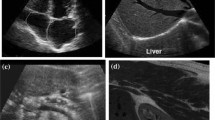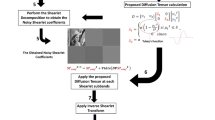Abstract
Speckle noise contaminates medical ultrasound images, and the suppression of speckle noise is helpful for image interpretation. Traditional ultrasound denoising (i.e., despeckling) methods are developed on two-dimensional static images. However, one of the advantages of ultrasonography is its nature of dynamic imaging. A method for dynamic ultrasound despeckling is expected to incorporate both the spatial and temporal information in successive images of dynamic ultrasound and thus yield better denoising performance. Here we regard a dynamic ultrasound video as three-dimensional (3-D) images with two dimensions in the spatial domain and one in the temporal domain, and we propose a despeckling algorithm for dynamic ultrasound named the 3-D Gabor-based anisotropic diffusion (GAD-3D). The GAD-3D expands the classic two-dimensional Gabor-based anisotropic diffusion (GAD) into 3-D domain. First, we proposed a robust 3-D Gabor-based edge detector by capturing the edge with 3-D Gabor transformation. Then we embed this novel detector into the partial differential equation of GAD to guide the 3-D diffusion process. In the simulation experiment, when the noise variance is as high as 0.14, the GAD-3D improves the Pratt’s figure of merit, mean structural similarity index and peak signal-to-noise ratio by 24.32%, 10.98%, and 6.51%, respectively, compared with the best values of seven other methods. Experimental results on clinical dynamic ultrasonography suggest that the GAD-3D outperforms the other seven methods in noise reduction and detail preservation. The GAD-3D is effective for dynamic ultrasound despeckling and may be potentially valuable for disease assessment in dynamic medical ultrasonography.









Similar content being viewed by others
Availability of data and material
The authors can provide raw data if required.
References
Rabbani H, Vafadust M, Abolmaesumi P, Gazor S (2008) Speckle noise reduction of medical ultrasound images in complex wavelet domain using mixture priors. IEEE Trans Biomed Eng 55:2152–2160
Wieclawek W, Pietka E (2019) Granular filter in medical image noise suppression and edge preservation. Biocybernetics Biomed Eng 39:1–16
Liu J, Huang TZ, Xu Z, Lv XG (2013) High-order total variation-based multiplicative noise removal with spatially adapted parameter selection. J Opt Soc Am A 30:1956–1966
Yoon C, Kim GD, Yoo Y, Song TK, Chang JH (2013) Frequency equalized compounding for effective speckle reduction in medical ultrasound imaging. Biomed Signal Process 8:876–887
Singh P, Shree R (2018) A new SAR image despeckling using directional smoothing filter and method noise thresholding. Eng Sci Technol 21:589–610
Singh P, Shree R, Diwakar M (2018) A new SAR image despeckling using correlation based fusion and method noise thresholding. J King Saud Univ Comput Info Sci
Singh P, Shree R (2020) A new homomorphic and method noise thresholding based despeckling of SAR image using anisotropic diffusion. J King Saud Univ Comput Info Sci 32:137–148
Singh P, Shree R (2016) Analysis and effects of speckle noise in SAR images. 2016 2nd International conference on advances in computing, communication, & automation (ICACCA) 1–5
Singh P, Shree R (2016) Statistical modelling of log transformed speckled image. Int J Comput Sci Info Security 14:426–431
Burckhardt CB (1978) Speckle in ultrasound B-mode scans. IEEE Trans Sonic Ultrason 25:1–6
Wagner RF (1983) Statistics of speckle in ultrasound B-scans. IEEE Trans Sonic Ultrason 30:156–163
Yu Y, Acton ST (2002) Speckle reducing anisotropic diffusion. IEEE Trans Image Process 11:1260–1270
Wang Y, Cheng JZ, Ni D, Lin M, Qin J, Luo X, Xu M, Xie X, Heng PA (2016) Towards personalized statistical deformable model and hybrid point matching for robust MR-TRUS registration. IEEE Trans Med Imag 35:589–604
Loupas T, McDicken WN, Allan PL (1989) An adaptive weighted median filter for speckle suppression in medical ultrasonic images. IEEE Trans Circuits Syst 36:129–135
Lee JS (1986) Speckle suppression and analysis for synthetic aperture radar images. Opt Eng 25:255636
Frost VS, Stiles JA, Shanmugan KS, Holtzman JC (1982) A model for radar images and its application to adaptive digital filtering of multiplicative noise. IEEE Trans Pattern Anal Machine Intel 2:157–166
Lee S, Chung W (2019) Quantitative analysis of effects of the grid specifications on the quality of digital radiography images. Australas Phys Eng Sci Med 42:553–561
Zhan Y, Ding M, Wu L, Zhang X (2014) Nonlocal means method using weight refining for despeckling of ultrasound images. Signal Process 103:201–213
Gu Y, Cui Z, Xiu C, Wang L (2014) Ultrasound echocardiography despeckling with non-local means time series filter. Neurocomputing 124:120–130
Zhang Q, Han H, Ji C, Yu J, Wang Y, Wang W (2014) Gabor-based anisotropic diffusion for speckle noise reduction in medical ultrasonography. J Opt Soc Am A 31:1273–1283
Perona P, Malik J (1990) Scale-space and edge detection using anisotropic diffusion. IEEE Trans Pattern Anal Machine Intell 12:629–639
Kakakhel M, Jirasek A, Johnston H, Kairn T, Trapp J (2017) Improving the quality of reconstructed X-ray CT images of polymer gel dosimeters: zero-scan coupled with adaptive mean filtering. Australas Phys Eng Sci Med 40:159–165
Huang QH, Zhang F, Li X (2018) Machine learning in ultrasound computer-aided diagnostic systems: a survey. Biomed Res Int 2018:1–10
Li SE, Li G, Yu J, Liu C, Cheng B, Wang J, Li K (2018) Kalman filter-based tracking of moving objects using linear ultrasonic sensor array for road vehicles. Mech Syst Signal Process 98:173–189
Ma F, Liu F, Zhang X, Wang P, Bai H, Guo H (2018) An ultrasonic positioning algorithm based on maximum correntropy criterion extended Kalman filter weighted centroid. Signal Image Video Process 12:1207–1215
Kawashima H, Ichikawa K, Hanaoka S, Matsubara K (2019) Optimizing image quality using automatic exposure control based on the signal-difference-to-noise ratio: a phantom study. Australas Phys Eng Sci Med 42:803–810
Shi J, Zheng YP, Chen X, Huang QH (2007) Assessment of muscle fatigue using sonomyography: muscle thickness change detected from ultrasound images. Med Eng Phys 29:472–479
Ni D, Ji X, Wu M, Wang W, Deng X, Hu Z, Wang T, Shen D, Cheng JZ, Wang H (2017) Automatic cystocele severity grading in transperineal ultrasound by random forest regression. Pattern Recog 63:551–560
Gabor D (1946) Theory of communication. J Iee E E 93:429–441
Daugman JG (1985) Uncertainty relation for resolution in space, spatial frequency, and orientation optimized by two-dimensional visual cortical filters. J Opt Soc Am A 2:1160–1169
Lyons MJ, Budynek J, Akamatsu S (1999) Automatic classification of single facial images. IEEE Trans Pattern Anal Machine Intell 21:1357–1362
Jun W, Yuanyuan W, Jinhua Y, Xinling S, Junhua Z, Yue C, Yun P (2015) Intelligent speckle reducing anisotropic diffusion algorithm for automated 3-D ultrasound images. J Opt Soc Am A 32:248–257
Wu L, Cheng JZ, Li S, Lei B, Wang T, Ni D (2017) FUIQA: fetal ultrasound image quality assessment with deep convolutional networks. IEEE Trans Cyber 47:1336–1349
Huang QH, Zheng YP (2008) Volume reconstruction of freehand three-dimensional ultrasound using median filters. Ultrason 48:182–192
Wang Y, Chua CS, Ho YK (2005) Face recognition from 2D and 3D images. Image Vis Comput 23:1018–1028
Linlin S, Li B (2008) 3D Gabor wavelets for evaluating SPM normalization algorithm. Med Image Anal 12:375–383
Leavline EJ, Sutha S, Singh DAAG (2014) On the suitability of multiscale image representation schemes as applied to noise removal. J Opt Soc Am A 10:1135–1147
Leavline EJ, Sutha S, Singh DAAG (2014) Fast multiscale directional filter bank-based speckle mitigation in gallstone ultrasound images. J Opt Soc Am A 31:283–292
Sun Q, Hossack JA, Tang J, Acton ST (2004) Speckle reducing anisotropic diffusion for 3D ultrasound images. Comput Med Imaging Graphics 28:461–470
Loizou CP, Kasparis T, Christodoulides P, Theofanous C, Pantziaris M, Kyriakou E, Pattichis CS (2012) Despeckle filtering in ultrasound video of the common carotid artery. Proc IEEE Int Conf Bioinf Bioeng 12:721–726
Yu J, Tan J, Wang Y (2010) Ultrasound speckle reduction by a SUSAN-controlled anisotropic diffusion method. Pattern Recog 43:3083–3092
Zhou W, Alan Conrad B, Hamid Rahim S, Simoncelli EP (2004) Image quality assessment: from error visibility to structural similarity. IEEE Trans Image Process 13:600–612
Zhang Y, Cheng HD, Huang J, Tang X (2012) An effective and objective criterion for evaluating the performance of denoising filters. Pattern Recog 45:2743–2757
Ishikawa H, Chen C-L, Wollstein G, Grimm J, Bilonick RA, Xu J, Sigal IA, Kagemann L, Schuman JS (2012) A novel signal enhancement method based on high dynamic range (HDR) processing concept for optical coherence tomography (OCT) images. Invest Ophthalmol Vis Sci 53:4060–4060
Funding
The work was funded by the National Natural Science Foundation of China (Nos. 61671281, 61911530249 and 62071285).
Author information
Authors and Affiliations
Contributions
All authors were involved in the work leading up to the manuscript. The results were appropriately placed in the context of prior and existing research.
Corresponding authors
Ethics declarations
Conflict of interest
The authors declare that they have no conflict of interest.
Consent for publication
The publisher has the authors’ permission to publish the relevant work.
Ethical approval
All procedures in the studies involving human participants were performed in accordance with the ethical standards of the institutional and/or national research committee and with the 1964 Helsinki Declaration and its later amendments or comparable ethical standards.
Informed consent
Informed consent was obtained from all participants included in the study. Consent from the patients was obtained with the condition that all data are anonymized.
Additional information
Publisher’s note
Springer Nature remains neutral with regard to jurisdictional claims in published maps and institutional affiliations.
Rights and permissions
About this article
Cite this article
Chen, H., Xu, H., Shi, P. et al. 3-D Gabor-based anisotropic diffusion for speckle noise suppression in dynamic ultrasound images. Phys Eng Sci Med 44, 207–219 (2021). https://doi.org/10.1007/s13246-020-00969-x
Received:
Accepted:
Published:
Issue Date:
DOI: https://doi.org/10.1007/s13246-020-00969-x




